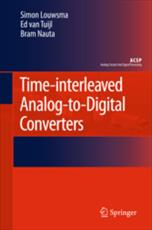دانلود کتاب مبدل های آنالوگ به دیجیتال ساختار مبدل های دیجیتال به آنالوگ مقاله مبدل های آنالوگ به دیجیتال مقاله در مورد مبدل های آنالوگ به دیجیتال مبدل سیگنال های آنالوگ به دیجیتال آی سی های مبدل آنالوگ به دیجیتال مبدل آنالوگ به دیجیتال adc مبدل های adc مبدل adc انواع مبدل adc مبدل آنالوگ به دیجیتال adc0804 مبدل adc چیست انواع مبدل های adc

کتاب مبدل های آنالوگ به دیجیتال با عنوان Time-interleaved Analog-to-Digital Converters مناسب برای دانشجویان کارشناسی ا رشد که در زمینه مدار مجتمع و طراحی مدارهای آنالوگ و طراحی مدارهای CMOS کار می کنند.
خلاصه ای از این کتاب و لینک دانلود این کتاب در سایت اشپرینگر را در زیر قرار داده ایم:
Preface
This book describes the research carried out by our PhD student Simon Louwsma
at the University of Twente, The Netherlands in the field of high-speed Analogto-
Digital (AD) converters. AD converters are crucial circuits for modern systems
where information is stored or processed in digital form. Due to increasing data
rates and further digitization of systems, the demands on the AD converters are increasing
in both sample-rate and number of bits. A fast and accurate AD converter
combined with digital signal processing offers an attractive alternative for the analog
signal chain still present in many actual receivers. This book offers an exploration
of fundamental and practical limits of high speed AD conversion, aiming at a step
forward in number of bits and sample-rate, while keeping the power consumption
low. To achieve high performance, a technique called time interleaving is used. Time
interleaving is the analog equivalent of parallel processing in the digital domain. To
implement this, instead of a single Track-and- Hold (T&H), we use a whole series
of them, each sampling a bit later than the previous one. In the design example in
this book we use 16 T&H circuits, followed by 16 sub-AD converters. The timing
alignment of these T&H circuits needs to be extremely accurate, and conventionally,
complex timing calibration is used to achieve this. Here however, it is shown
that even better performance can be achieved by a compact and good design of the
timing circuit without requiring any timing calibration. The circuits use a minimum
of transistors that cause timing inaccuracies and special layout techniques are the
finishing touch. Thanks to the absence of a control range for the timing, the amount
of jitter is also reduced. To save power and to keep the input capacitance low, small
sized transistors are used in the time-interleaving T&H circuitry. Only simple DC
calibrations are needed to make the 16 paths behave equally over the whole input
frequency range. An extensive analysis of accuracy and timing requirements is
given and circuit solutions are described in detail. After the input signal is sampled
by a T&H section, a sub-ADC finalizes the conversion. Pipeline AD converters are
popular for conversion rates around 100 MS/s, but they suffer from the fact that
even in the first stage of the pipeline the full accuracy for settling is required. This
makes the design of high speed in combination with a high accuracy quite a challenge.
Instead of that, we use sub-ADCs based on Successive Approximation (SA).
As explained in this book, this has quite some advantages: A SAR ADC contains
less critical analog blocks, and its power consumption can be ten times less than a
comparable pipeline ADC. A potential disadvantage of Successive Approximation
converters is the relatively low maximum sample-rate. This problem is tackled with
a new overrange technique that greatly reduces the demands on settling time per
conversion step and that postpones the critical decision to the last conversion step.
This offers great advantage over a Pipeline ADC, where the first residue amplifier
must settle to full accuracy to avoid unrecoverable analog errors in the conversion
process. The work described in this book shows state-of-the art performance and
describes techniques, which gain popularity among today’s AD converter designers.
We enjoyed carrying out the research with Simon and we hope you will enjoy
reading the results.
فرمت فایل: PDF
تعداد صفحات: 148
پس از ثبت دکمه خرید و تکمیل فرم خرید به درگاه بانکی متصل خواهید شد که پس از پرداخت موفق بانکی و بازگشت به همین صفحه می توانید فایل مورد نظر خورد را دانلود کنید. در ضمن لینک فایل خریداری شده به ایمیل شما نیز ارسال خواهد شد. لینک دانلود فایل به مدت 48 ساعت فعال خواهد بود.
مطالب مرتبط
